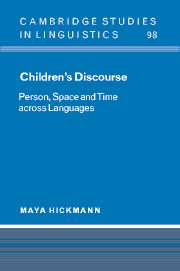Preface
Published online by Cambridge University Press: 22 September 2009
Summary
The aim of this book is to explore two questions in the study of first language acquisition: the role of structural and functional determinants during acquisition, and the extent to which the developmental process is invariant vs. variable across languages. In order to address these questions, I examine within a functional and cross-linguistic perspective the acquisition of a variety of linguistic devices relevant to three domains of child language: the denotation of entities, the expression of motion and location, and the marking of temporal-aspectual distinctions. In relation to the first question, my aim is to determine the relative impact of two types of factors during language acquisition: syntactic and semantic factors that operate at the sentence level; and discourse pragmatic factors that operate beyond the sentence, particularly those that regulate the flow of information across utterances as a function of presupposition and focus in discourse. Furthermore, the book is framed within a comparative perspective, in which evidence from different languages is repeatedly brought to bear on the second question, in light of various claims concerning universal vs. language-specific determinants of acquisition.
After an introduction presenting the general aims of the book, subsequent chapters are divided into two parts. The first part provides a general theoretical background and overview of the relevant developmental literature.
- Type
- Chapter
- Information
- Children's DiscoursePerson, Space and Time across Languages, pp. xv - xviPublisher: Cambridge University PressPrint publication year: 2002

